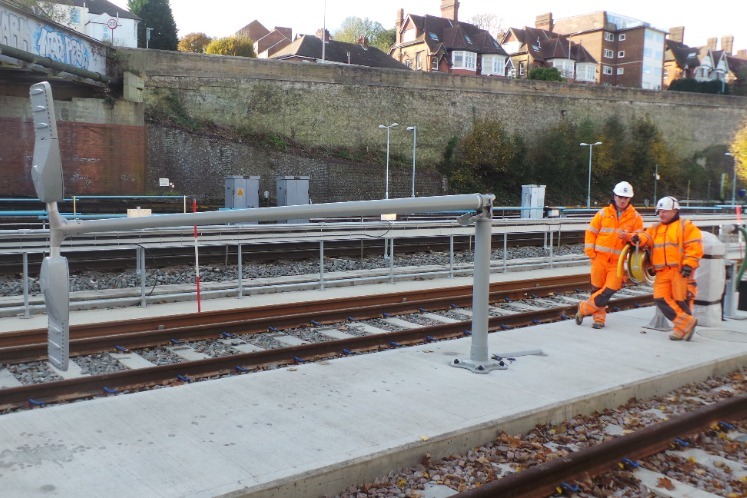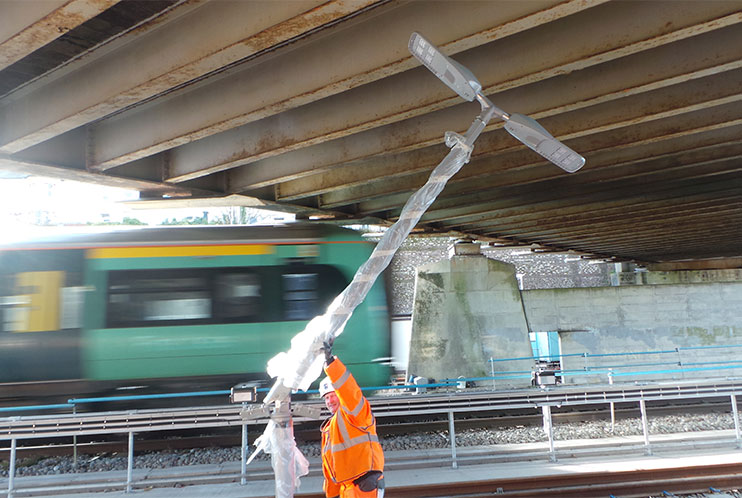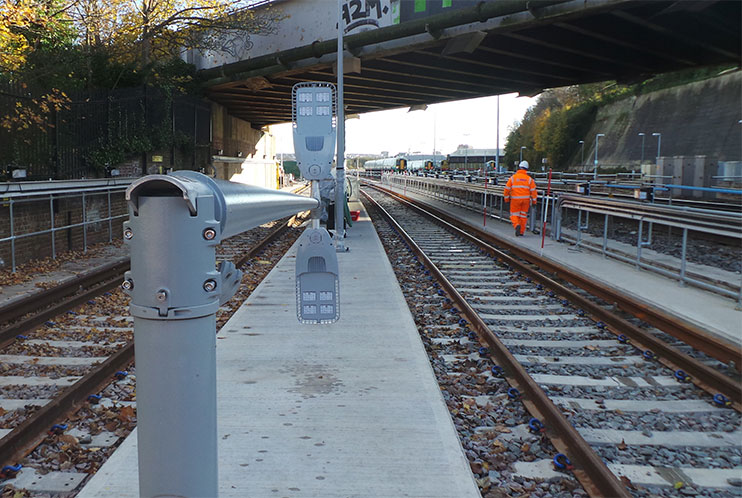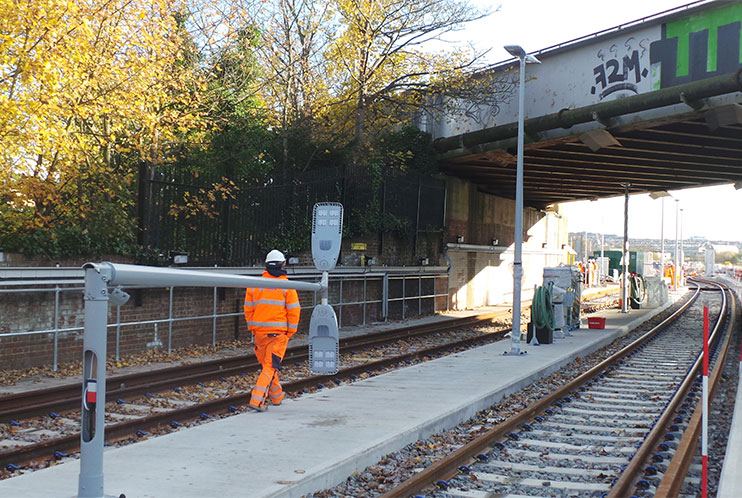Whilst one product may be the ideal solution in street lighting, in the rail sector this solution may be wholly inadequate.
As a result, a column supplier such as the Aluminium Lighting Company must be flexible, responsive, and above all have a meticulous eye for detail when venturing into this sector. Fortunately, these are attributes afforded by being a family run business. The Rail Stabling Yard in Brighton was no exception to this.
This project required 4 and 5m raise & lower columns that were simple to install and maintain with single-key, one-person operation. However, the solution also had to mitigate against some of the major issues associated with rail electrification and vicinal structures.
Design
Network Rail’s Brighton facility is a DC railway siding, opening the possibility of touch potentials and stray currents, owing to the proximity of various power supply systems. As the EFCOG Electrical Safety Improvement Project explains, ‘It involves a fault current flow in the earth establishing a potential difference between the earth contact point and some nearby conductive structure or hardware’.
Network Rail also commonly received complaints that their lighting columns were ‘live’, however the reality was that train passengers built up a static charge whilst travelling, and upon exiting the carriage were ‘shocked’ as the static current discharged through the columns – a particular issue on stations with narrow platforms. To mitigate against such issues, a bespoke isolation solution was utilised.
Usually our aluminium columns are supplied in their brushed natural state, or a high gloss finish where requested, despite there being no need for any corrosion protection other than at the root. But our Customer & Production Support Engineer at the time, Dr Paul Mason, took on the project and advised that an Abcite coating over the length of the column would provide the appropriate solution. Following several tests proving the solutions’ feasibility, we were given approval for the scheme.
The solution reduced touch potential to the lowest practical values, minimising exposed contact points, ensuring Network Rail operatives could – and can continue – to safely operate our Echalon® Mk III Raise & Lower system without solely relying on Personal Protective Equipment (PPE) such as conductive mats. It is part of our ethos here at ALC that we provide solutions to challenges that our competitors are less inclined to tackle.
How does our Design Process Work?
The design stage of our bespoke products is critical – it is a stage of development that is a distinguishing feature of ALC in the market with an Independent Chartered Structural Engineer, R & D and mechanical engineers on-site.
Stage 1:
Once we had received the enquiry, draft specification drawings were completed and were followed by a set of structural calculations, verified by an Independent Structural Engineer, to determine whether the product was fit for purpose.
Stage 2:
The product was assessed for conformity to applicable standards and requirements including our CE certification scope. Primarily, this centres around the Street Lighting Standard BS EN 40, encompassing structural strength analysis to accurately define the structure and the loads passing through that structure. Similarly, our close adhesion to NHSS6, ISO 9001 and ISO 14001 and alignment with National Operations Publications such as RIS-7702-INS ensured our columns satisfied the necessary standards for rail infrastructure.
Stage 3:
3D CAD drawings and strength calculations were returned for customer verification. The order was received, a delivery date was set and production began.
Manufacture
Assembling the product at our facility in Port Talbot, South Wales, was equally important. We utilise our patent-pending processes such as structural bonding to ensure the products leaving our premises are compliant, exactly to specification and ultimately represent the quality of design and craftsmanship the industry expects of ALC.
Stage 1:
Inspection and Cutting: Both the column and the Echalon® cartridge were inspected before the column was measured, marked and cut.
Stage 2:
Preparation: Burrs and the oxide layer were removed from the column’s inner surfaces to ensure optimum bonding. The Echalon® cartridge was then inserted as per the specified operational directions and specific offsets before four structural adhesive feed holes were drilled.
Stage 3:
Bonding and Coating: The bonding of the Raise & Lower system utilised our patent-pending process. Structural adhesive was injected into the feed holes and cured for 30 minutes. The feed holes were then re-drilled and 6mm stainless steel pins were inserted. Finally, a pull cord was fed through column and Echalon® cartridge for cable installation, the column was applied with a powdered Abcite coating in our paint booth at our Port Talbot facility, and the completed unit was inspected by our Quality Assurance Manager.
Keeping Contact with Customer (During & After)
The development of bespoke products requires a synergy between customer and manufacturer. It necessitates regular communication, customer support and ultimately the development of a strong working relationship to produce the correct solution which, in this instance, was particularly appropriate to meet Network Rail’s stringent specifications.
As mentioned at the beginning of this article, this project highlighted the differences between the highways and rail sector. Such ‘stringent specifications’ from Network Rail included considerations such as the wind pressure from passing vehicles – in this instance, trains – an aspect that is often under less scrutiny in the highways sector. ALC’s commitment to the sustenance of engineering as a fundamental discipline meant that our column ranges were fit for rail from the outset – albeit requiring bespoke lowering directions to comply with the Rail industry’s safe working boundaries.
Following the installation, a site visit was organised to ensure compliance and customer satisfaction – Matt Cunningham, Director of Engineering for Emico at the time explained:
“These are light enough to carry into position. The Raise & Lower mechanism is very simple to operate so we could fit the lanterns quickly and get the columns up with a minimum of fuss”
Into the Future
The Echalon® Raise & Lower system has come a long way since its Mk I debut in 2009, increasing in capacity and improving its aesthetic appeal among other enhancements. Our Mk IV is currently in development, with our design and technical teams working hard with the aid of our 3D printing technology to construct our most advanced Raise & Lower system to date.
Whether it be lighting, signalling, level crossing solutions or meteorological masts, the ALC Echalon® Raise & Lower system provides the pragmatic solution to maintaining many rail structures, and with installations in Canada and the Middle East the Echalon® unit has proven its worth in the very toughest of environments.

 01639 852 502
01639 852 502




